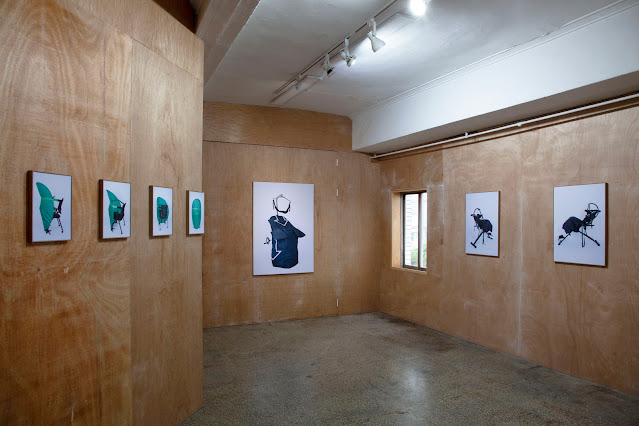The Juxtaposition Technique of Hacked Objects - according to Jihyun Jung's alien assembly/disassembly methods
Juri Cho
However, Jung's sculptural methodology of assembling off-the-shelf products as ready-made objects is not completely new. It is also the legacy of Dadaists and Surrealists that has continued since the early 20th century. If a juxtaposition technique such as the“Beautiful as the chance encounter of a sewing machine and an umbrella on a dissection table,” a symbolic verse from the 19th-century poet Comte de Lautréamont's prose poem Les Chants de Maldoror, was the core methodology of literary aesthetics envisioned by Surrealists in the past, then we can say that today's artists are determined to go beyond the juxtaposition of objects that radiates“sporadic beauty” and reach post-artistic formation through active hacking and design combination of existence and objects. Although“coincidence of process” and“consequential beauty” are far from the goal of Jung's work, there is a distinct difference from classical formative work in that it does not presuppose transcendental values and the legitimacy of form from her formative practice and that it flattens the hierarchy between her pieces and objects with the same logic.
Mixed media, 110x110x50cm,
2022
On the contrary, the series of works assembled and dismantled by Jung trigger an immediate psychological response. The sense of volume and structure of the device in contact with or connected to the body and the feeling of the foreign matter about the silhouette appear on various scales. Maybe it is a level of sensitivity difference that is intolerable to sensitive people's eyes, but acceptable in dull people's view. What is the reality of such uncomfortable emotions? Jung's works evoke the body. It is inevitable to not summon the classic Freud definition of“uncanny” in the face of the chilling sensation surrounding the place where someone lay in, sat on, draped on, leaned on, and gazed at. Things that have appeared at the wrong time and in the wrong place are bizarre. This is because they disturb the tranquility of real existence that is here now. They are large masses wrapped in black textiles, like shrouds, glistening with only their thin legs showing, and also iron equipment that cannot be distinguished between massage chairs, game chairs, or surgical chairs. They are in a state in which they are indistinguishable between lifelike or lifeless, main body or parts, and proliferated or concealed. Why did the artist become so immersed in making such uncanny masses?
Jung's work began with specific experiences and voluntary explorations of the relationship between digital devices and the body. As an artist that works with three-dimensional objects, she was interested in the sense of connection between smartphones, laptops, and various electronic devices, which are interfaces that directly come in contact with her body, and she focused on the unique formative and spatial gestalt generated between them. Like the artist's discovery, the body, digital devices, and peripherals that physically mediate between them connect like a single body and become an organic mass that transmits and receives data when power and Wi-Fi are secured. Otherwise, they are like senseless corpses like hosts that are blocked from each other. Considering the strong synchronization between analog bodies and digital content, such as eating while watching a mukbang and controlling the interval and breathing under the direction of running apps such as RunDay, we cannot disagree with the point. As a millennial artist, a generation that is physically and emotionally closely attached to electronic devices, the problematization process and formative response to this phenomenon have become the core of Jung's recently developed works. The hybrid combination method of diverse objects and everyday devices centered on various types of electrical and electronic equipment is a kind of an empty set to reveal the subjects' physical response and cognitive state in response to the designed space. Furthermore, it clearly shows the theatrical characteristics of sculptures. What are the senses and situations that people project into the sculptural space where the body has eluded? It might be an excessive dependence on electronic devices as the artist claims and its resulting sense of isolation, a different level of emotional attachment, or a sense of unconscious erotics and mutual amusement formed with machines. It depends on the psychological distance we have with her works and on the individual's experience and perception emanating from the pieces.
What was she trying to hack? Maybe it was the drowsy experience of unconsciously becoming one with all sorts of machinery devices, the moment of feeling fear and helplessness instead of feeling relieved being without electronics, or an indoor scene dominated by non-human objects and devices. While the landscape of things becomes our portrait, we attempt to erase the sense of familiarity one by one, overlap anxious things, and bond the starting points of objects and the tip of the body. In an ominous imagination, we try to hack into the external world and the inside of us, referring to Jihyun Jung's assembly and dismantling methods as guidelines.
Juri Cho (curator, art critic)
Cho studied psychology, art history, culture policy, and visual culture studies at under graduate, master’s and doctorate levels respectively, and has hands-on experience curating at a variety of culture and arts institutions from the mid-2000s. She has been an independent curator for the past ten years, and her main focus is on research-based projects centered on exhibition curation and critical writing. Cho is committed to creating artistic knowledge regarding ways for curating practices at an individual level to effectively manifest in the public sphere, and coming up with new ways to collaborate with artists and institutions. Cho’s major exhibitions include My Sleep(2022, Culture Station Seoul 284), Triple rings; Replicas from the Yesterday, Tomorrow (2021, Culture Station Seoul 284), Gihoek Festival (2020, Oil Tank Culture Park), WHITE RHAPSODY (2020, Wooran Foundation), Tenaciously, Tenacious (2019, d/p), Looms & Battles (2018, Total Museum of Contemporary Art), Mille-feuille de camélia (2016, Arko Art Center), and participated in curating numerous international exchange and public art projects.




